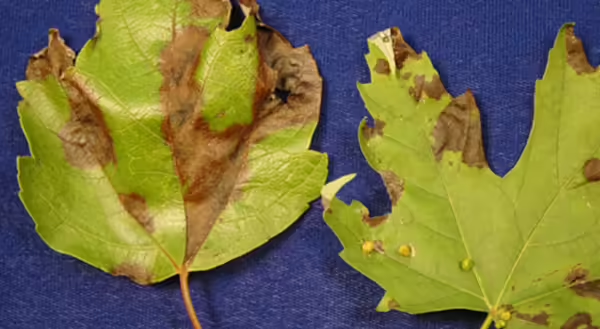
If you are spending more time out in your backyard this week, you may have noticed some of our central Illinois trees are super ugly this spring. Maple leaves have black splotches, sycamore branches are falling to the ground and ginkgoes leaves are sparse and crinkled. All these symptoms are tree issues that link back to the cool wet spring and late frost.
Maples are suffering from fungal diseases like anthracnose and maple leaf blister.
Anthracnose causes new leaves to turn black and shrivel and older leaves to have dark brown lesions. The symptoms generally start at the bottom part of the tree and leaves fall off. Maple leaf blister lesions have a somewhat rounded shape, compared to irregular and angular anthracnose lesions.
Anthracnose on Sycamores causes branches to fall off the trees and kills off buds causing the leaves to be slow to leaf out in spring. Anthracnose is always present, but symptoms become worse with the right environmental conditions.
The injury caused by anthracnose and maple leaf blister is mostly aesthetic and will not harm the health of the tree. The disease may cause some defoliation, but a new flush of leaves will emerge in warmer and drier weather. One of the best practices is picking up and removing diseased leaves and twigs.
Report of blackening distorted ginkgo leaves falling off the trees can be blamed for the late freeze we had in the first week of May. Just as ginkgo buds were breaking and the leaves were unfurling, they were zapped by freezing temperatures. These trees will use extra reserves to produce a new flush of leaves by early summer.
With diseased trees and frost zapped trees, take extra steps this summer to keep these trees healthy by watering during times of drought and fertilize.
If the trees have been planted in the last few years, apply 1.5 gallons per inch of caliper. The caliper is the distance around the trunk. For instance, if I use a measuring tape and record four inches, I then need to give that tree 6 gallons of water weekly. If temperatures are above 90 degrees, I would double to 12 gallons weekly. If a tree or shrub is planted this year, it needs to be watered in this manner every two to three days. Established trees should be watered after stressful events and during major droughts.
Wait until mid-summer or fall to fertilize established trees that experienced a stressful event in order to build up their reserves. Most trees grown in Central Illinois are just fine without additions of fertilizer. Apply granulate fertilizer at the ground level using a spreader or apply a light layer of compost. Cover all the area below the canopy of the tree. Typically, a lawn fertilization program will supply enough nutrients for the woody plants that surround it.
To learn more about fertilizing woody plants and fertilizer application rates and methods, see Fertilizing Trees and Shrubs